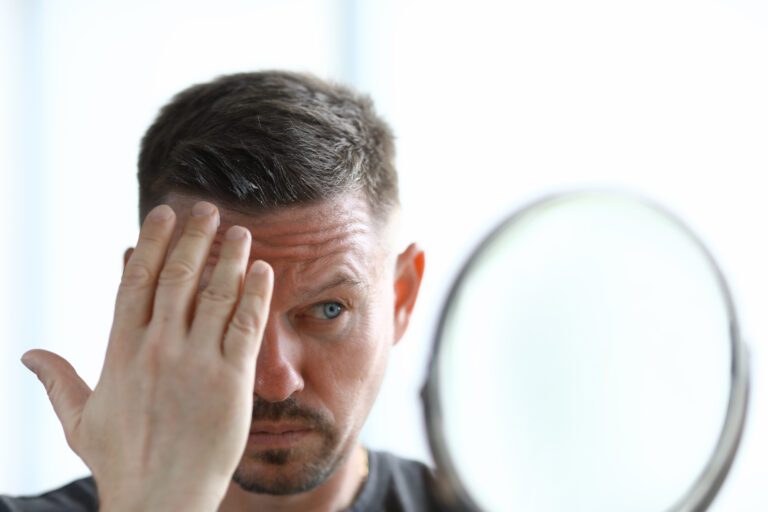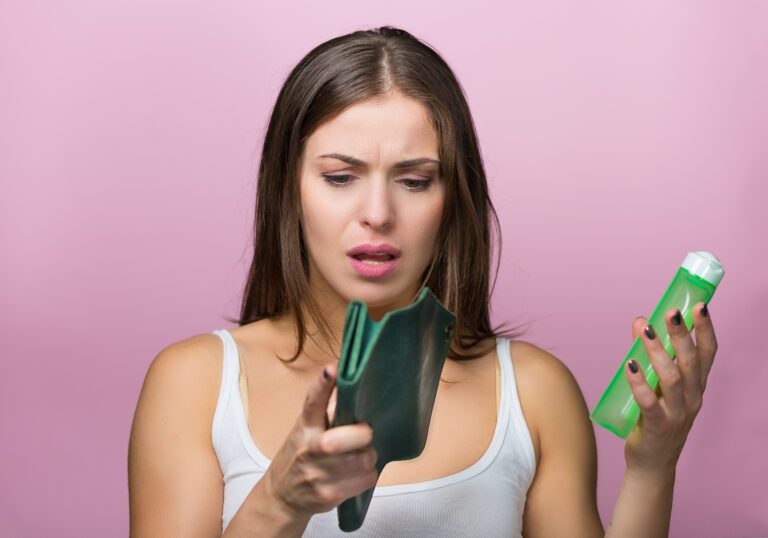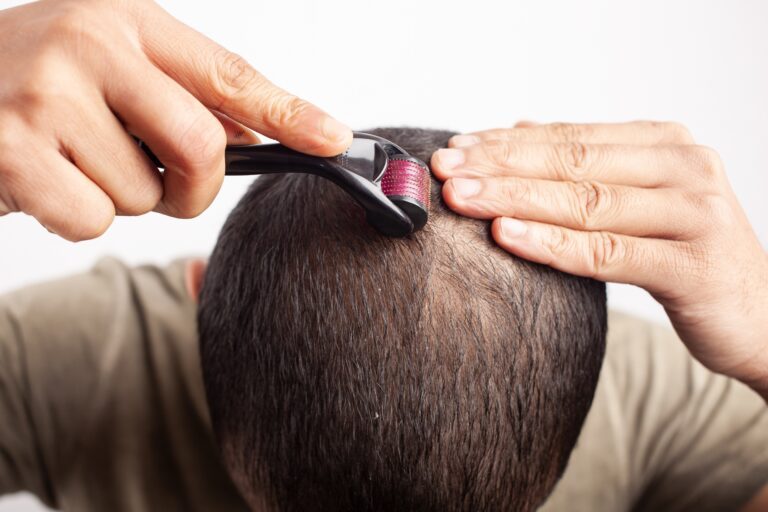How Do Minoxidil & Rogaine Work To Regrow Hair?
Are you worried about hair loss and asking around for a solution? You probably keep hearing two words popping up here and there; Minoxidil and Rogaine.
Understandably, you start asking questions like, how does minoxidil work? How does Rogaine work? How do they contribute to hair growth?
In this article, we’ll answer all these questions so you can decide if minoxidil and Rogaine are suitable for you. So, stick around!
How Does Hair Grow?
To understand how minoxidil and Rogaine work, you need to know how hair grows first.
At first glance, hair growth might seem like a simple process. Our hair just grows over time, right? Well, it’s more complicated than that. So, let’s break it down into simple terms.
The hair growth cycle is made up of four stages. Each stage takes time and can be affected by external factors, like age and health.
The first stage is called anagen. It’s where your hair follicles start to grow hair until it reaches the second stage, the catagen.
In the catagen stage, your hair stops growing, and your follicles start shrinking. This transitional phase separates your hair strands from their blood supply.
Then comes the telogen stage. It’s also called the resting stage, as your hair strands don’t grow or fall out. They stay where they are until they enter the final stage, the exogen.
In this stage, your hair falls out, allowing your follicles to re-enter the anagen stage. Then, we repeat the process all over again.
How Do People Lose Their Hair?
Now that we covered the hair growth cycle, let’s see how people lose their hair.
It has to do with your hormones—testosterone, to be specific.
In male-pattern baldness, your hair follicles turn testosterone into dihydrotestosterone (DHT). These follicles, however, become quite sensitive to it.
DHT forces your hair follicles to shrink, producing shorter, thinner hair strands. Eventually, your follicles stop growing hair altogether, and you start balding.
As for females, they produce testosterone, too, but much less than men.
It also helps that they produce enough estrogen to hide DHT’s effect. It starts to show when women slow down their estrogen production.
What Is Minoxidil?
If you look into the history of minoxidil, you’ll see that it’s pretty interesting. Minoxidil wasn’t intended to be a treatment for hair loss.
Originally, scientists developed it to treat high blood pressure. During the drug trials, they observed signs of hair growth in patients who were balding.
That piqued their interest, so they looked further into minoxidil’s hair growth abilities. Eventually, they created a format of minoxidil that you can use to treat hair loss.
What about Rogaine? Is it also an accidentally-discovered product?
No, it’s not. There isn’t a drastic difference between minoxidil and Rogaine.
Minoxidil is a generic component that contributes to hair growth. Rogaine is a hair growth brand that uses minoxidil as an active component.
Since there isn’t a drastic difference between Minoxidil and Rogaine, anything we cover in the following sections applies to both.
How Does Minoxidil/Rogaine Work?
That’s the part you’ve been waiting for. Now that we laid the groundwork, let’s see how minoxidil and Rogaine work.
- What Is the Science Behind It?
This is going to sound weird, but we don’t know exactly how Rogaine works. We do, however, have a general idea.
When you apply Rogaine, sulfotransferases in the scalp turn the minoxidil inside it into minoxidil sulfate.
Do you remember the telogen stage? The one where your hair rests before starting to fall. Minoxidil sulfate shortens that stage and lengthens the anagen stage, the growing stage.
Rogaine can also stop hair follicles from shrinking through DHT’s effect.
So, it’s easier for blood to flow around hair follicles, and your hair prematurely enters the lengthened anagen stage, where it starts growing again.
Et voila!
- Does Minoxidil/Rogaine Regrow Hair?
So, is minoxidil foolproof, or is all this scientific talk mere speculation? After all, how can we tell for sure if we don’t fully understand how it works?
Well, studies have been conducted to test how effective it is. For the most part, it seems to have solid results.
Of course, as with any treatment, there are bound to be patients who don’t respond to minoxidil.
The FDA even approved it as an effective treatment for AGA, although doctors still use it to treat other hair loss issues.
- How to Apply Rogaine?
Rogaine comes in two forms, solution, and foam. We’ll show you how to apply both.
Whether you’re using foam or solution, make sure your hair and hands are completely dry.
So, don’t take a shower right before applying Rogaine. If you do, give your hair enough time to dry.
If you use a solution, you get a dropper or a spray to apply it. When using a dropper, squeeze the solution into it, then drop it on the balding areas.
If you have a spray, pump the solution on the balding areas.
It’s pretty much the same thing with foam.
Drop half a capful of foam on your fingers and apply it to the balding areas of your scalp.
When you massage the balding areas, don’t spread the foam on your hair. Make sure you apply it to the scalp to get the most effective results.
Even with these measurements, it’s better to follow the instructions of the manufacturer if they dictate otherwise.
Wash your hands with soap and water, and you’re done!
If you want to apply any kind of hair routine, you might want to wait until your hair dries completely.
- How Long Does It Take To Work?
It differs from one person to another. Research suggests you might notice minimal improvement after eight weeks.
For obvious improvement, though, you might have to wait for four months.
It’s important to note that minoxidil doesn’t grant you permanent hair growth. If you want its effects to last, you can’t stop using it.
If you do, your hair will fall out again within 3-6 months.
- What Does Minoxidil Do to Healthy Hair?
So far, we’ve only tackled balding heads. What if you have good hair, but you just want it to thicken a little bit? Would it work?
There isn’t a definitive answer to that question, as there are several factors to consider.
Yes, both Rogaine and minoxidil have shown they can increase hair growth. However, as mentioned before, stopping it makes your hair fall out again.
At this point, there’s no telling whether you lose all your hair or just the hair you grew with the treatment.
It’s better to consult a doctor in this matter.
Who Shouldn’t Take Minoxidil?
Before you get excited about this treatment, you need to consult a doctor on whether or not you should try it.
It’s not only that minoxidil and Rogaine don’t work on everyone, there are cases where you shouldn’t take it in the first place.
Let’s see some examples!
Pregnant Women
If you’re pregnant, or planning to get pregnant, taking minoxidil isn’t a good idea.
It’s a controversial issue, as there aren’t any studies on the effect of minoxidil on pregnant women.
However, we do have a case of a 28-year-old pregnant woman who regularly used minoxidil for her hair loss issue.
After 22 weeks, her fetus showed clear signs of brain and heart damage.
Another case shows a pregnant woman who used minoxidil regularly and ended up having a fetus with caudal regression.
There isn’t concrete evidence that minoxidil is the cause of these problems. In fact, that’s why the FDA gave it a C on how safe it is to use during pregnancy.
There isn’t sufficient data to tell how it’s going to affect pregnant women.
You should check with a doctor before deciding to take it.
People Under the Age of 18
In one study, researchers observed that teens and kids who took topical minoxidil had severe medical problems.
In one case, a 12-year-old boy used minoxidil to treat his alopecia areata. After one month, the kid developed tachycardia, a case where one’s heart rate increases alarmingly.
His heart rate stabilized only after quitting minoxidil.
Another case shows a 10-year-old girl using minoxidil to treat alopecia totalis. After one month, the girl started experiencing palpitations and dizziness that stopped after quitting minoxidil.
Wrapping Up
Overall, studies seem to show that minoxidil can have solid results, especially with AGA. That’s what the FDA approved it to treat.
So, how does minoxidil regrow hair?
It increases the blood flow into your hair follicles to speed up the hair-growing process.
It also shortens the telogen stage and forces your hair follicles to enter the anagen stage prematurely, giving your hair more room to grow.
After applying minoxidil, expect to see maximum results after four months. However, it’s better to consult a doctor on whether or not you should take it in the first place.







